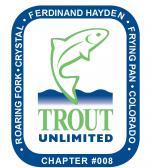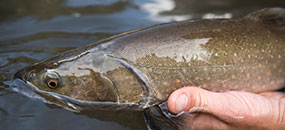Location: Runs through Aspen
Type of stream: Freestone
Angling methods: Fly, spin
Species: Rainbow, brown, brook
Access: Moderate
Season: Year-round
Supporting Services: Aspen
Short take: Ride the trail for the rainbows
Handicapped Access: Yes
Closest TU Chapter: Ferdinand Hayden
Roaring Fork River and the Fryingpan River which joins it roughly 20 miles downstream from Aspen in Basalt might be thought of as cousins, but several times removed. The “Pan” is a tailwater, but the “Fork” flows unfettered from the outlet of Independence Lake in the Hunter –Frying Pan Wilderness to its junction with the Colorado River at Glenwood Springs. During its 70 mile race to the Colorado, the Fork drops about 6700 feet more than four times as much as the Mississippi in its 2,340 journey to the Gulf of Mexico. No wonder it’s called Roaring Fork.
For its entire length the Fork is classified as Gold Medal water and only flies or other artificial lures are allowed. Route 82 picks up the Fork about a mile west of Independence Pass and follows it all the way to the Colorado. The upper 16 miles of river, a small bouldery stream with plunge pools and runs, transit the White Mountain National Forest. You’ll find rainbows and a few wild brook trout in this water. Most of the upper Fork, with the exception of a few private inholdings, is open to public angling.
Public access becomes more of a challenge three miles upstream from Aspen. However the city’s HeH HHerron Park is the western terminus of the 54-mile long Rio Grande Trail, a hiking and biking path that follows an old railroad bed along the Fork to its mouth. Bring your mountain bike, pack your gear and five-piece rod, pick up the trail at one of its many accesses, and ride to water that most other anglers can’t reach.
On Roaring Fork, TU’s Ferdinand Hayden Chapter plays an important role. Over the years members have established drop structures to aerate the flow, and the chapter was instrumental in securing the wild river and catch and release designations for the Fork. The chapter is allied with the Roaring Fork Conservancy in an ambitious effort to monitor the rivers temperatures and their impact on trout.





